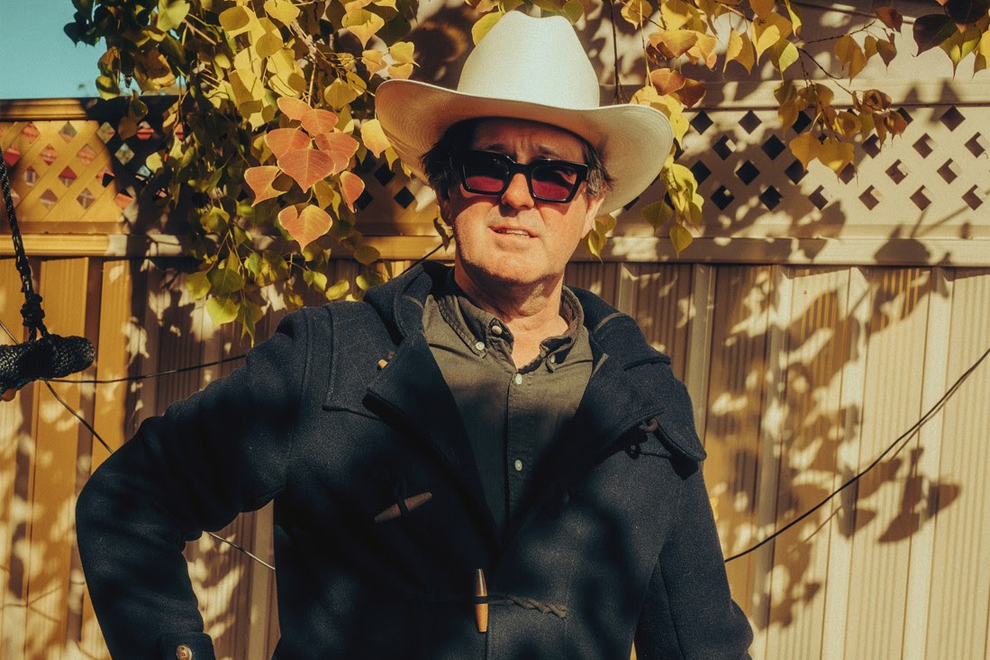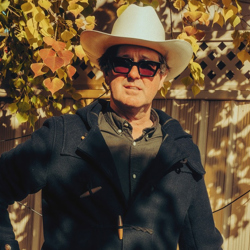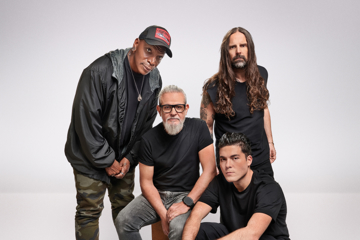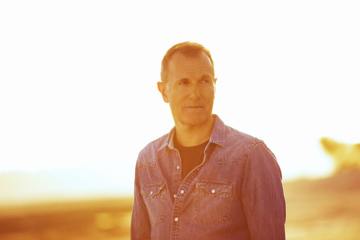‘Fortunately, Sanity Prevailed’: Dave McCormack & The Polaroids Offer A History Of Popular Music
With his band The Polaroids releasing their first full-length album in over 20 years, Oz rock icon Dave McCormack discusses navigating the murky depths of memory and time. Warning: may contain traces of 'Bluey.'

Dave McCormack (Credit: Supplied)

Oz rock mainstay Dave McCormack has never seemed to take the peripheral aspects of his artistic endeavours particularly seriously – he’s all in on the music itself, but the other stuff not so much – which in part explains why the new record from his outfit David McCormack & The Polaroids has been given the somewhat haughty title A Complete History Of Popular Music.
Even the accompanying press release doubles down on the ambitious conceit – offering, “In the magnum opus, McCormack embarks on an audacious endeavour to distill the essence of popular music’s sprawling narrative into a singular cohesive work” – but it’s all just a cunning ruse, with the Custard frontman and his crack band of Polaroids instead doling out another dozen doses of their own distinctively catchy brand of earworm indie rock.
“Someone reminded me the other day that the very first band I was in, Who’s Gerald?, the first cassette we released was called Greatest Hits,” the singer smiles. “I'm piecing together that there's a theme here of overreaching – a distinct theme of overreach.
“I didn't know what to call it. There’s a podcast called The History Of Rock Music In 500 Songs – which is fascinating – so I was just riffing on that: A Complete History Of Popular Music.
“And then the guy who did the artwork, Jeremy Saunders, he had an amusing suggestion – he reckoned that we should call it A Complete History Of Popular Music: Part 1. I loved that idea because it doesn't make sense – how could it be a complete history of it if it’s only the first part? – but fortunately, sanity prevailed.”
Don't miss a beat with our FREE daily newsletter
McCormack recalls getting blowback over the title of Custard early 1993 EP Brisbane, with many scenesters of the day feeling that the precocious young band were perhaps getting ahead of themselves.
“When I talk about blowback, probably like five people even knew about it,” he laughs. “But there was a bit of a concern from other people in Brisbane along the lines of, ‘How dare you? How dare you claim to represent a whole city?’
“And I of course thought it was a love letter to Brisbane, because back in the ‘80s and the ‘90s to make it you had to get out of Brisbane, but we stayed in Brisbane until arguably we’d peaked and were on the way down and then we moved to Sydney. So I saw it as a badge of honour, like, ‘Fuck you, Sydney and Melbourne, this is Brisbane! We can do it!’”
It was indeed Sydney in the early-2000s where the Polaroids story began. When Custard first pulled up stumps at the tail-end of the 20th century McCormack started a new band The Titanics and released a couple of albums, but when that group also ran its course The Polaroids were born.
A loose coalition of prominent figures from the Sydney scene – today comprising Shane Melder (Sidewinder, Died Pretty, The City Lights), Patrick Matthews (The Vines, Youth Group), Cameron Bruce (Paul Kelly) and Matt Galvin (Eva Trout, The Barbarellas) – The Polaroids put out two albums in the early years of the Millennium before they too were consigned to the back-burner.
It was only a passing conversation at McCormack’s own birthday party which started the ball rolling for The Polaroids to reform after their extended absence, the one-off reunion gig quickly culminating in 2024 comeback mini-album Get Old.
“The Polaroids sort of faded off in 2009 and then Custard sort of picked up the slack and we did a bunch of records,” McCormack recalls, “but I had a birthday party in maybe 2023, and my friend Shane Melder – who’s always been the drummer in the Polaroids – he was there and we were just saying, ‘Man, we've got so many songs that no one ever hears and we don't get to play – let's do a gig at The Golden Barley and make it free and just get some songs together!’
“So we did that, and you know what it's like you play with people and you get inspired – you bounce ideas off them – to the point that by the time I got home from the gig I was, like, ‘I’ve got to record! I’ve got to do a record with these guys!’
“So we quickly recorded Get Old in one afternoon with Wayne Connolly and then put it out as soon as possible, and that’s how that came about,” he adds. “And now strangely enough, the reason for getting the band back together was to play all those old songs again, but now we've got so many new songs that we don't seem to play many of the old songs! Oh man!”
“So we put out Get Old and then we did a double album for Custard [2024’s Suburban Curtains], and I just felt like after that double album and that big three month tour we did – which was great, and culminated in that fantastic show at The Princess Theatre in Brisbane, which was so much fun – suddenly I just felt that I needed to get back into playing with The Polaroids in Sydney,” he explains.
“Hometown gigs are great. It’s really nice to do a gig in a city where it can be early evening and you can go home to your own bed, instead of the rigmaroles of touring – meeting at the airport at 7am, fly to somewhere and then you go to the soundcheck and then the gig's not till 10 o'clock and then afterwards there’s a party, and then you've got to wake up and the cycle continues.
“Whereas it's really nice to be playing near your home. We’re doing an album launch in Sydney in a couple of weeks and we're on at nine o 'clock and it's free to get in and I'll just drive there, or I’ll get an Uber there. It's just so nice to be a local.”
McCormack agrees with the assertion that, despite his current living arrangements, Custard seems to be his Brisbane band while The Polaroids are his Sydney band.
“Oh yeah, 100%,” he grins. “From some people, there's a push to say that Custard are an Ipswich band because that is what we sort of started, so let's just say 'Southeast Queensland’.
“Nah, Custard's always going to be Brisbane. Despite the fact that none of us live there – although Matthew [Strong]’s moving back – but for many years none of us have lived there, it’s just we're too branded: we’re the Brisbane band. It's the same as Regurgitator, they’re a Brisbane band. You can't change it."
Though joined by a common thread of DNA there’s a subtle difference between the music of Custard and The Polaroids, and McCormack explains that this is due to the music he’s written for each project having been filtered through the lens of his respective bandmates.
“The older I get, the more I enjoy what other people bring to my songs,” he tells. “When I was young – like in the Brisbane EP years – I thought I knew everything. And I’d think, ‘You should play that and you should do this and that should be on a keyboard’ and so forth, but now with Custard and with The Polaroids I just bring an outline and then whatever everyone plays is right.
“That definitely happened on this Polaroids album – we put down the basic tracks and Cameron plays his stuff and we've got an extra member now, Matt Galvin, who's a bit of a Sydney legend and he plays some tasty guitar, I tell ya. It’s great hanging out with musicians who with everything they play I love it. It’s the same with Patrick Matthews on the bass, he comes up with stuff that just blows me away.
“It never ceases to amaze me how good humans are at creating things as opposed to machines creating things. Humans do everything so much better and, yeah, it's out of time and maybe it's out of tune a bit, but it’s so much more interesting. In this world where AI is just taking over – because I'm in the music composition biz, right, I do music for TV shows – and AI can do all that now, but it's just so boring.
“I'd rather hear someone out of time and out of tune, but having a vibe and into it than something that's perfectly created.”
The Polaroids laid down A Complete History Of Popular Music over two frenetic days at Sydney’s Hercules Street Studios, with veteran producer Wayne Connolly manning the desk.
“Wayne's incredible, he’s sort of like your favourite pair of shoes – sometimes you don't even know you've got them on, even though you're going a long distance,” the singer chuckles. “I’ve got a photo of me and Wayne from like 1991, when we first sort of worked together – I've been doing stuff with Wayne forever.
“Wayne's got a studio here in Sydney called Hercules Street, where we did Get Old and now A Complete History Of Popular Music – it's the old Vanda & Young studio so it's got all the old desks and everything there, and you go to the toilet and there's AC/DC quad boxes stored in the bathroom area! It’s amazing. Wayne's got it all set up there and we just rocked in and did it in two days, it was so much fun.
“And this is another thing about working with people who you trust and you know: Wayne does a mix, and I don't think I've ever asked him to revise a mix. I think he might've sent his own revision of one or two mixes, but pretty much everything you hear is as Wayne sent, as he heard it and did it.
“He added some really creative production flourishes and I just don't question it, I just really enjoy hearing what he does. Some people get in the studio and they'll argue for six hours about a snare reverb – I've been with people like that and it's an imperceivable difference. I'd much rather just record it on a Walkman – boom, done. Wayne's like my own personal Walkman.”
Despite A Complete History Of Popular Music not really being a comprehensive of the musical form it does cover a lot of sonic terrain within the parameters of The Polaroids’ sound – tinges of genres such as funk, country and even classic rock popping up at regular junctures – and the singer explains that this is merely indicative of his own broad musical tastes.
“I think the title does reflect a certain depth and breadth,” McCormack muses. “People often criticise me for doing too many varied things – maybe none well enough or with proper commitment – but I mean, that's just the way I am. I love The Beatles’ White Album, and that’s got like five different albums on there.
“So A Complete History Of Popular Music was a great way to disguise my ‘bowerbird-ism’, if you know what I mean, taking little bits from everywhere.
“Take a track like Heavy Metal, that’s a song dating back to the ‘90s that I just never got around to recording. And then Cronies Of The Summertime, which is the end of Side A, that was a song that I think I did with Custard like 10 or 15 years ago – we might've recorded it, but it just disappeared. So they were sort of older songs, but the rest were just new.
“And it goes back to how being in the band room with new people just turns on a tap for me. After doing all the Custard stuff – which is great, I utterly loved it – but then being with a different bass player, keyboardist, drummer, it's like, ‘Oh, they can do that! That makes me think we could do a song like this”. It will just inherently go down in different directions, so it's been pretty fun. It's been very fun and very effortless as well.”
Despite its protracted genesis Heavy Metal is one of the album’s standouts, the tract about diving into the heavier end of the musical spectrum delivered in a laidback cadence with a distinct country inflection.
“I’d forgotten all about that song,” McCormack says. “Paul Hester, the dearly departed drummer from Crowded House, had a TV show called Hessie's Shed back in the day and there's video of me performing that song with him in the mid-’90s. So it's got to be at least that old, and it sounds like a pretty similar version, so I didn't really change it.
“It's just one of those ones that I sort of did and then forgot about. And when I was panicking – not panicking, but when I was thinking, ‘I’m not going to be able to have enough songs for an album!’ – that’s why I started with those two that I just had in the bottom drawer, and from there, it just went on and on.
“I love how Cronies Of The Summertime ended up too, a lot of that's thanks to my friend Michael Lira. He's a freakishly good multi-instrumentalist and he's been in wonderful bands and does wonderful music for TV and motion picture, and he did that from just a basic track that I sent to him. He's living in Brissie now, actually in West End, and I sent it to him and I said, ‘Michael, do your thing, man!’, and he did all those strings and the horns. I just love it.
“Once again, it's a bit Beatles-y – there’s a lot of Beatles on this album. The older we get, the more we sort of go back to what we started listening to, and I think all I listened to from about the age of one until 12 was The Beatles and that's probably about it, on cassettes and vinyl and reel-to-reel. So when Michael sent me all that stuff that was Beatles-y, it was like, ‘Yes! This is exactly what I want!’”
From a lyrical perspective there’s a bit of a recurring motif throughout A Complete History Of Popular Music touching upon looking backwards and reconciling the passing of time, something that McCormack feels becomes inevitable once an artist reaches a certain vintage.
“Yeah, we're looking in the rear vision mirror now, aren't we?” he smiles. “There's a lot more behind than there is up front, so it’s pretty natural. There’s a lot of reflection on all these recent songs that I'm doing. You can't really be writing too much about, you know, ‘I'm in the physical and mental peak of my life, so bring it on baby!’ Now it's all, like, ‘Geez, we've been around for a while and how good was it when we did that? And what do we have up next? Who knows?’
“And because I've been traveling around a lot lately, I'm getting a lot of ideas. I was in an airport in Houston, Texas and I was on one of those travelators and they had an installation by this plein air artist. As I was going along I couldn't read it all cause I was on the travelator, but the artist was discussing their art and saying how it's intense and deep and it kept them up at night and stuff like that, and I was quickly transcribing what I could into my phone – that became the lyrics to the song Plein Air Artiste.
“It's good traveling around and just sort of picking up pieces from wherever you are.”
On the live front The Polaroids only have the solitary hometown launch lined up for now, and McCormack is revelling in the convenience of the truncated venture.
“I'm looking forward to it immensely,” he offers. “These days launches are just so much more fun than they used to be. Back in the old days, an album launch was a bit of a big deal – we would have organised everything and done this and done that in an attempt to make it special and memorable.
“Now it's just absolutely just turn up, play, and it's great; I love it. And I love doing free gigs because there’s just no pressure – it’s, like, ‘Yeah, whatever. Come, go, stay for a while, don’t stay, whatevs.’
“And Mixtape Brewing where we’re playing is great, it’s a really big warehouse but the sound's really good. They've done a really good acoustic treatment, so it's not like a big reverb-y hall. I find all these places in Sydney are so much better than they used to be in the ‘90s or early-‘00s, everywhere has really good PAs and everything's a lot more professional than it used to be in the old days.”
Speaking about the now, despite all of his decades spent at the music coalface McCormack is arguably better known for something that started off as a side lark – voicing the character of Bandit Heeler in the global smash kids TV show Bluey.
Since debuting in 2018 the Brisbane-written and produced animated series has become a global phenomenon, an incredible Aussie success story that’s only going to ramp up further with the recent announcement of the feature-length Bluey movie that is slated for a theatrical release in mid-2027.
Despite being a fair way off, it’s a venture that’s already stirred up incredible hype and anticipation across all age demographics.
“There’s so much excitement for the movie,” he chuckles. “What I've noticed though is I had to do some press for something the other day and people are now asking whether I’m surprised that people are still into Bluey – it’s the first time I've heard still. It’s always been, ‘Wow, are you amazed that people love Bluey? Isn’t it incredible?’, but now it's, ‘Are you amazed that people still love Bluey?’, because it's been around a while.
“But yeah, it's the sweetest gig in the world because I don't have to do anything – I just act like myself – and everyone loves the show and, and the people who do it are great. And it's all made in Brissie and I'm just going to soak it up. The movie's going to be really good, I know. And people are going to love it, so I'm just along for the ride.
“I think a lot of my stuff's already done. They write it all first obviously, and then they do all the voices and then they have to animate it. And I think the animation takes up the time, that's where the years come into it. A movie is like an hour-and-a-half long, and even with computers or whatever they use, it just takes forever.
“So I think the voices – the part that I do – is the fun bit. I just act like an idiot in the studio and then they cut it all up and make it good. But I think people are going to love it – I know people are going to love it!”
David McCormack & The Polaroids’ A Complete History Of Popular Music is out now. They’ll launch the album with a free show at Mixtape in Marrickville, NSW on Friday, October 24th.
This piece of content has been assisted by the Australian Government through Music Australia and Creative Australia, its arts funding and advisory body








